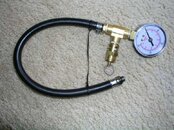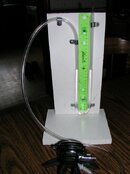You are using an out of date browser. It may not display this or other websites correctly.
You should upgrade or use an alternative browser.
You should upgrade or use an alternative browser.
1st time reg rebuild questions...
- Thread starter Rainh2o
- Start date
Please register or login
Welcome to ScubaBoard, the world's largest scuba diving community. Registration is not required to read the forums, but we encourage you to join. Joining has its benefits and enables you to participate in the discussions.
Benefits of registering include
- Ability to post and comment on topics and discussions.
- A Free photo gallery to share your dive photos with the world.
- You can make this box go away
R
redacted
Guest
No reason to spend too much on the IP gauge. I made one from a gas engine compression gauge ($20) by adding a $10 NPT to LPI connector that seemed quite adequate. Then I picked up a water pressure tester gauge for $5 just to give it a try. It was a few PSI off (no big deal) and, perhaps more importantly, mirrored the reading stability of the more expensive gauge. As long as you are in the ballpark, the stability of the reading is more important as a diagnostic tool.
A couple of comments on an IP gauge. First off 300psi is too high, you want a gauge that under normal operation reads somewhere about 2/3 of full scale, 180 psi is about right for an IP gauge. Cheap ones are fine, the exact pressure is no where near as important as being able to monitor for a constant lockup and creep, neither require a lab grade/calibrated gauge.
NEVER EVER use an IP gauge without either a pressure relief valve installed in the IP gauge line OR having a working, down stream second stage connected to the reg at the same time. Ignor this warning and you will have an exploading hose or gauge in your face sooner or later.
NEVER EVER use an IP gauge without either a pressure relief valve installed in the IP gauge line OR having a working, down stream second stage connected to the reg at the same time. Ignor this warning and you will have an exploading hose or gauge in your face sooner or later.
Yes I read that in the sample of the book online about using a second as a relief valve...makes perfect, safe sense.
I'll look at engine compression gauges as well awap,
exact pressure only needs to be in the ball park for me I think at this time, I am not into tec diving and only have done 100 feet and less since I begin diving...dont really plan on going deeper unless something REALLY interesting pops up, I like watching the wildlife more then anything.
Didnt get by harbor freight tonight but will tomorrow to see what other gauges they may have. Gotta go order my book!
I'll look at engine compression gauges as well awap,
exact pressure only needs to be in the ball park for me I think at this time, I am not into tec diving and only have done 100 feet and less since I begin diving...dont really plan on going deeper unless something REALLY interesting pops up, I like watching the wildlife more then anything.
Didnt get by harbor freight tonight but will tomorrow to see what other gauges they may have. Gotta go order my book!
I find a good range one at Northern Tool (aka Northern Handyman). It's 200 psi max so the 140 psi I typically use is almost in the sweet spot for that gauge. They also sell a 175 psi air compressor popoff valve that works good. Most regs actually specify a range, usually around 130-140 (Apexs is 130-145) so obviously the exact value is not a big concern to the manufacture, bottom line, exact pressure is not important, does it return to the same value each time and does it creep are important.
Here is one I have used for a long time. It is made from NT parts and a cut off LP hose.

And while you are part hunting, go ahead and get the parts to make a simple manometer (used in place of a magnahelic).

Here is one I have used for a long time. It is made from NT parts and a cut off LP hose.

And while you are part hunting, go ahead and get the parts to make a simple manometer (used in place of a magnahelic).

R
redacted
Guest
I find a good range one at Northern Tool (aka Northern Handyman). It's 200 psi max so the 140 psi I typically use is almost in the sweet spot for that gauge.
I thought the "sweet spot" for a pressure gauge was mid-scale and that was the basis for measuring accuracy. And that is why old SPGs with 3600 and 4000 psi are now replaced by SPGs with a 5000 or 6000 max scale.
In powerplant training we were taught 2/3s scale..
The guy to ask would probably be TFSails, I think tool cal used to be his line of work. But if memory serves me correctly the middle third of the scale is the most accurate portion and the section where the tool cal tech usually aims for the most accuracy. One thing about a lower maximum scale is that it easier to read.
halocline
Contributor
I thought the "sweet spot" for a pressure gauge was mid-scale and that was the basis for measuring accuracy. And that is why old SPGs with 3600 and 4000 psi are now replaced by SPGs with a 5000 or 6000 max scale.
I've heard something similar, maybe from you! Anyhow, you'd really want the SPG to be most accurate at the bottom end of the scale, so I guess one with a lower total would be theoretically more accurate at lower pressures, but probably not by enough to even measure.
Getting back to the IP gauge, I have a feeling that none of the typical cheap ones we use are very well calibrated. I doubt if a range to 300 or 200 makes any difference on it's own.
In terms of measuring drop and recovery, I think there are other variables that affect the behavior of the gauge more than the mechanism itself, in particular flow rates and dynamics within the hose set up you use. Most of us use a LP inflator hose, rather than installing the IP gauge inline on the 2nd stage hose. I'm pretty certain this causes a bit of a venturi effect that can really effect the way the needle drops on initial purge. Otherwise, why would my MK15, a very high low reg, drop more than the MK5s, and the MK2, (lowest flow) drops the least, all with exactly the same 2nd stage attached. There's no other explanation, because clearly the MK15 has a higher flow rate, and flow rate/pressure are proportional in the same restricted flow path.
Eventually I got smart and attached 2 b/a 2nds, both with very aggressive purges, and tested IP drop with both on full purge. After an initial big drop, the MK15 recovered to about 7 PSI under IP, while the MK5s and 2 stayed substantially lower. I also tried a MK25 for laughs, less than 5 PSI drop under full purge, again after an initial (maybe half a second) big drop. The only explanation I can think of is when the air starts moving down to the 2nd stages, there must be a venturi effect pulling pressure out of the LP inflator hose beyond just the IP drop.
keyshunter
Contributor
I have a Scubatools inflator hose plug in IP gauge, bought some years ago from Scubatools previous owner. When tested against both an inline gauge and a plug in gauge by a tech whom I respect, my gauge shows IP consistently 15psi higher. I just allow approximately that amount and move on.
Similar threads
- Replies
- 5
- Views
- 348
- Replies
- 2
- Views
- 216



